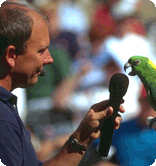Fearful Macaw

Hello, I took in a Yellow Collared macaw about 18 months ago. He is now about 18 years old and has spent most of his life being neglected, mistreated and passed from home to home. I know that he has been flicked and hit on the beak, had his cage hit to stop him screaming and at one stage was left in a back room for years because he was so loud. (there is more bad treatment in his past, but exactly what it was I don’t know). When I first saw him he would lash out at the cage bars when anyone came near his cage. He also hadn’t been out of his cage in years or been able to bath in that time (he could only get his head into his tiny water bowl).
He is doing a lot better now, I have gotten rid of his swearing, he whistles for attention instead of screaming (most of the time), he gets out, wanders around exploring, and will usually end up sitting on my foot playing with my shoe laces and preening, i have also got him to step on and off a dowel so i can move him around.
The problem is you cannot get a hand close to him without him biting a finger right to the bone (can’t blame him considering what hands have done to him in the past). On a few occasions he has stepped from the dowel onto my hand and for a second he seems relaxed, then suddenly his eyes pin, the feathers on his neck stand up and he latches onto a finger. Occasionally he will let you scratch his head through the cage bars, but only for a few seconds and then, eyes pin, neck feathers up and he lashes out. he is always showing he wants attention, but when you get close with a hand it is almost like he has a “flashback” to his previous experiences with hands.
Whenever possible I try reinforce when he is relaxed around hands. the question now is, is there hope that he will get over his fear of hands,or is it possible his fear is just too deep and he will always have a problem with hands? Will he be better off if i find him a partner and build an aviary for them, or possibly even send him to a sanctuary where he wont need to interact with people? I have to admit that I am a little wary of him after nearly needing stitches a few times, but i am happy to put in more time and effort if that is what is needed. In the end it is about what is best for him. Some advice would really be appreciated.
Thanks
Bruce

Hi Bruce, My name is Melissa Williams, and I am one of the trainers with Natural Encounters, Inc.
It is so awesome of you to take this bird on and give it the kind of home it deserves! Working with animals always has its challenges, but when you bring a history of mistreatment and neglect into the picture a whole other set of challenges arise. The good news, however, is that with patience (which you seem to have a lot of) and positive reinforcement you have the opportunity to rebuild trust and continually work on the relationship! It’s great that you have already taken so many steps in the right direction: making sure he has the opportunity to bathe, giving him enough space, and giving him attention on a level that he is comfortable with. Because of the negative experiences he's had in the past, it may take a longer period of smaller progressions until he is comfortable stepping up and spending time on your hand, but I do believe it is possible, especially with the progress you have made so far. One thing to keep in mind is to only move forward as fast as the bird is comfortable. The other thing to consider is if and how the bird would benefit from learning to step onto and spend time on your hand to begin with. While it may seem like a simple behavior to us, it is a big step to ask a bird to step onto what, for them, is probably a much less stable surface than a perch or dowel, and one that will likely bring them into much closer proximity to the body of the person doing the handling.
One of the goals is to keep every interaction positive, even if that means keeping interactions short and having more of them throughout the day. Because you mentioned he has a history of biting, he has likely learned to bite when he gets uncomfortable in order to go home and be left alone. Your goal will be to continue to be sensitive to smaller changes in his body language that occur before biting to allow the bird to let you know when he is uncomfortable, so that you can avoid having to get into a biting situation in the first place. By keeping each interaction short, you put him home or give him the space he likes to feel comfortable before he feels the need to practice biting. This also allows you to reinforce each positive interaction you have since it ends when he is still comfortable. As time goes on and your relationship builds, you will be able to slowly increase the amount of time you spend giving him attention, but it will have to be very slowly.
It’s also great that you are working on reinforcing him for being calm when hands are around. Another great way to actively desensitize him to hands would be to start with your hands at a distance where the bird is comfortable and reinforce his successively smaller movements closer and closer to them, instead of bringing the hands closer and waiting to see when the bird becomes uncomfortable; this empowers the bird to use his body language to determine what distance is acceptable. You can start by placing your hands several feet away from him (or the closest point that he is completely comfortable with) and having some of his favorite treats a few steps towards your hands in front of him so that he has to take a step or two towards your hand to get them. Because he has an aversive history of hands approaching him, this gives him the power of choice as to whether to approach your hand or not. Once he seems completely confident approaching your hand at that distance, you can begin to move the reinforcements slightly closer to your hand, keeping in mind to keep your hand very still and not make any sudden movements that could make him nervous. Eventually, the end goal would be him walking up to you, stepping onto your hand, and taking the reinforcement nicely out of your fingers. It is important to help build his confidence by giving him the opportunity to approach an object or person whenever possible instead of them approaching him.
I think he has found a wonderful home with you and your immense amounts of patience. All of the negative experiences he has had in the past will have to be slowly and surely replaced with positive reinforcement and positive interactions that will build the trust necessary for a good relationship with him, but I believe it can be done! We wish you the best of luck, and look forward to hearing about your successes in the future.
Sincerely,
Melissa Williams
Natural Encounters, Inc.

































